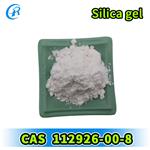Silica glass is a continuous network of corner-sharing SiO4 tetrahedra where each oxygen bridges two tetrahedra (i.e. only Q4 speciation). However, a more complex system might contain 75% Q3 (tetrahedra with one free non-bridging oxygen) and 25% Q2 (two non-bridging oxygens). For silica glasses, the first diffraction peak, Q1, has been associated with intermediate-range ordering with a periodicity of 2π/Q1 ~ 6 Å. This ordering beyond the first few nearest neighbour tetrahedra arises from the boundaries between successions of cages comprising a 3-D covalent network structure. Therefore, the position and shape of the first sharp diffraction peak Q1 can provide information on different-sized ring distributions within the material. The second diffraction peak at position Q2 has been linked to chemical or extended range ordering with a periodicity of 2π/Q2 ~ 3 Å, and the local Si–O–Si and O–Si–O bond-angle distributions can persist to distances as large as > 5 Å.
Typical properties: S.A.250m^2/gSilicon oxide is used as a catalyst support material having a high surface area. It acts as a medium to which catalyst is affixed. Several metals such as platinum, rhodium, ruthenium, silver, copper, nickel, iron, manganese, cobalt, tungsten and gold are supported over silicon dioxide and used as a catalyst in synthetic chemistry for various applications. For example, silica-supported gold catalysts is used for carbon monoxide oxidation by a solution-based technique.



